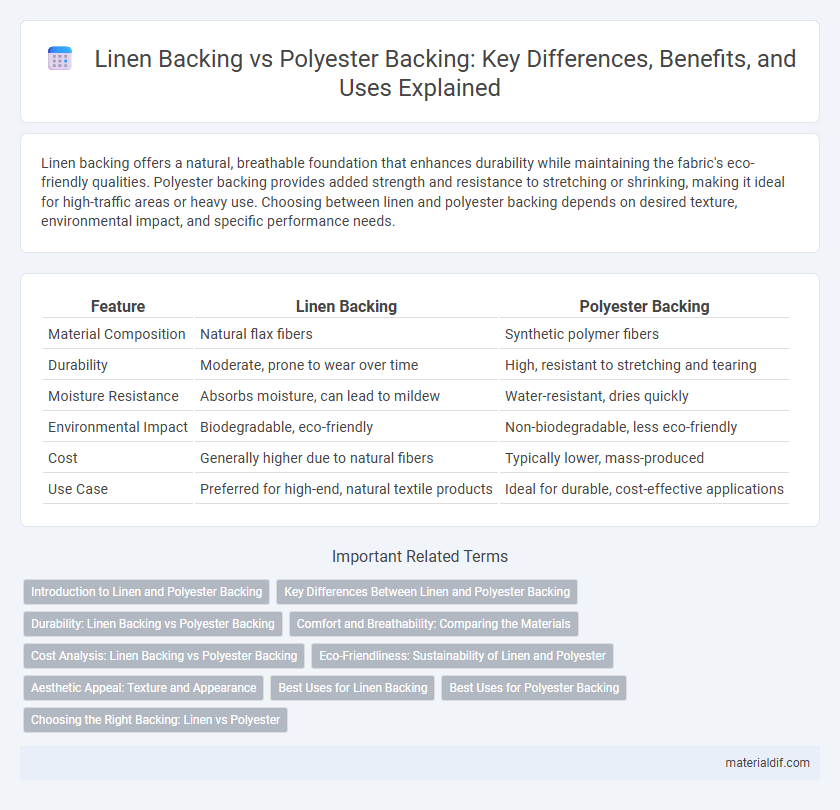Linen backing offers a natural, breathable foundation that enhances durability while maintaining the fabric's eco-friendly qualities. Polyester backing provides added strength and resistance to stretching or shrinking, making it ideal for high-traffic areas or heavy use. Choosing between linen and polyester backing depends on desired texture, environmental impact, and specific performance needs.
Table of Comparison
| Feature | Linen Backing | Polyester Backing |
|---|---|---|
| Material Composition | Natural flax fibers | Synthetic polymer fibers |
| Durability | Moderate, prone to wear over time | High, resistant to stretching and tearing |
| Moisture Resistance | Absorbs moisture, can lead to mildew | Water-resistant, dries quickly |
| Environmental Impact | Biodegradable, eco-friendly | Non-biodegradable, less eco-friendly |
| Cost | Generally higher due to natural fibers | Typically lower, mass-produced |
| Use Case | Preferred for high-end, natural textile products | Ideal for durable, cost-effective applications |
Introduction to Linen and Polyester Backing
Linen backing consists of natural flax fibers known for durability and breathability, enhancing canvas strength while maintaining moisture control. Polyester backing, a synthetic alternative, offers superior resistance to stretching and environmental factors, providing a stable, wrinkle-resistant foundation. Both backings improve artwork longevity, with linen lending a traditional texture and polyester ensuring consistent tension.
Key Differences Between Linen and Polyester Backing
Linen backing offers superior breathability and natural moisture-wicking properties compared to polyester backing, which is synthetic and less breathable. Polyester backing provides greater durability and resistance to stretching, making it more suitable for high-traffic or humid environments. The key differences lie in linen's eco-friendliness and texture versus polyester's strength and longevity in upholstery and fabric applications.
Durability: Linen Backing vs Polyester Backing
Linen backing offers natural strength and breathability, enhancing durability in textiles used for upholstery or canvas art. Polyester backing provides superior resistance to moisture, stretching, and abrasion, making it a more durable choice for heavy-duty applications. Comparing durability, polyester backing generally outperforms linen backing due to its synthetic resilience and longer lifespan under high-stress conditions.
Comfort and Breathability: Comparing the Materials
Linen backing offers superior comfort and breathability due to its natural fibers, which allow better air circulation and moisture absorption compared to polyester backing. Polyester backing tends to trap heat and moisture, making it less comfortable in warm or humid conditions. Choosing linen backing enhances overall comfort by providing a cooler, more breathable sleeping or sitting experience.
Cost Analysis: Linen Backing vs Polyester Backing
Linen backing typically incurs higher costs due to the natural fiber's durability and eco-friendly production process, making it a premium choice for upholstery and art canvases. Polyester backing offers a more budget-friendly alternative, providing strength and resistance to stretching at a lower price point suitable for large-scale projects. Evaluating long-term investment, linen's longevity may justify upfront expenses, whereas polyester's affordability caters to cost-sensitive applications without compromising essential performance.
Eco-Friendliness: Sustainability of Linen and Polyester
Linen backing is highly eco-friendly due to its natural, biodegradable fibers derived from flax plants that require minimal water and pesticides during cultivation. Polyester backing, being synthetic and petroleum-based, poses significant environmental concerns such as non-biodegradability and high energy consumption during production. Choosing linen backing supports sustainable textile practices by reducing carbon footprint and promoting renewable resources.
Aesthetic Appeal: Texture and Appearance
Linen backing offers a natural, textured surface that enhances the authenticity and richness of artwork or wallpaper, providing a warm, organic aesthetic. Polyester backing tends to be smoother and more uniform, delivering a sleek, modern appearance but lacking the depth and tactile interest found in linen. The choice between linen and polyester backing significantly impacts the visual appeal, with linen favored for its classic, textured look and polyester for its clean, contemporary finish.
Best Uses for Linen Backing
Linen backing is highly valued for its durability and natural breathability, making it ideal for archival artwork and high-quality prints that require long-term preservation. Its ability to prevent moisture buildup helps maintain the integrity of delicate textiles and paintings, which polyester backing may not provide as effectively. Artists and conservators prefer linen backing for canvas paintings and vintage textiles due to its superior strength and compatibility with natural fibers.
Best Uses for Polyester Backing
Polyester backing offers superior moisture resistance and enhanced durability, making it ideal for high-humidity environments such as kitchens and bathrooms. It supports heavy-duty applications where linen needs reinforcement against stretching or shrinking, commonly used in upholstery and wall coverings. Its dimensional stability ensures long-lasting performance without compromising the natural texture of linen fabric.
Choosing the Right Backing: Linen vs Polyester
Choosing the right backing for fabric involves evaluating durability and texture; linen backing offers a natural, breathable foundation ideal for high-quality upholstery and artwork, while polyester backing provides enhanced strength, wrinkle resistance, and moisture durability suitable for heavy-use applications. Linen backing maintains a traditional aesthetic with its organic fibers, ensuring longevity and a refined finish, whereas polyester backing supports increased stretch and resilience, making it a practical choice for commercial and high-traffic environments. Understanding the specific needs of your project, including exposure to wear and environmental factors, guides the decision between linen's classic appeal and polyester's synthetic advantages.
Linen Backing vs Polyester Backing Infographic

 materialdif.com
materialdif.com